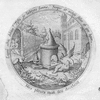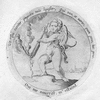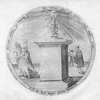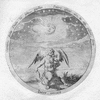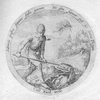Mes pleurs mon feu decelent [3]
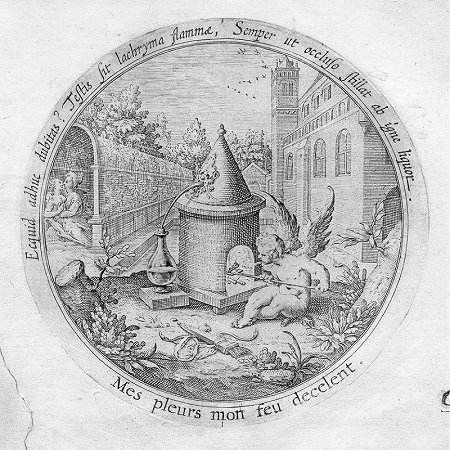
Mijn vyer brand meer end’ meer/ wat sal het eynde wesen?
Het water spruyt uyt1 vier/ end’ kan my niet ghenesen:
Mijn vyer dat wordt ghestoockt/ mijn vyer dat brand en blaeckt
Soo langhe dat mijn vyer my een fonteyne maeckt.
Van tranen vloey’ ick wech/ wil zy my niet verhooren
Ick moet doch eyndelijck int water gans versmooren.
O wonderbaren brant/ van branden comt my dat.
Ick swemme daer ick gae/ den brant die maeckt my nat.
Het water spruyt uyt1 vier/ end’ kan my niet ghenesen:
Mijn vyer dat wordt ghestoockt/ mijn vyer dat brand en blaeckt
Soo langhe dat mijn vyer my een fonteyne maeckt.
Van tranen vloey’ ick wech/ wil zy my niet verhooren
Ick moet doch eyndelijck int water gans versmooren.
O wonderbaren brant/ van branden comt my dat.
Ick swemme daer ick gae/ den brant die maeckt my nat.

Translations
 |
Mijn tranen verraden mijn vuur. |
 |
My tears bear witness of my fire. |
 |
Waarom aarzel je nog? Laten mijn tranen getuigen zijn van mijn liefdesvuur, zoals er altijd condens vrijkomt bij vuur dat is opgesloten. |
 |
What do you hesitate? Let my tears reveal that I am burning, just as water always trickles from a banked fire. |
Literature
-
Henkel and Schöne, Emblemata
 , col. 1407
, col. 1407
-
Praz, Seventeenth-Century Imagery
 , pp. 89-90
, pp. 89-90
-
Luijten, Gezien of gelezen?
 , pp. 48-49
, pp. 48-49
Sources and parallels
- Same emblem in 1601 edition: Mes pleurs mon feu decelent [3] (in: Daniël Heinsius, Quaeris quid sit Amor (c. 1601))
[Compare
![Compare [compare]](/static/images/compare2.gif) ]
]
- Source for the motto, pictura and entire emblem: Scève, Délie
 , embl. 23
, embl. 23
- Probable source for the pictura and perhaps the entire emblem: La Perriëre, Theatre
 , embl. 79
, embl. 79
- A parallel (and probably adaptation) for the latin subscriptio, the
pictura and the entire emblem: Sunt lacrymæ testes [95] (in: Otto Vaenius, Amorum emblemata (1608))
[Compare
![Compare [compare]](/static/images/compare2.gif) ]
]
- A parallel for the pictura: Covarrubias, Emblemas Morales
 , bk/embl. III/63
, bk/embl. III/63 - A parallel (and probably adaptation) for the pictura (background): Fit spolians spolium. [12] (in: Jacob Cats, Sinne- en minnebeelden (1627))
[Compare
![Compare [compare]](/static/images/compare2.gif) ]
]
-
A parallel in the 1616 edition: motto and subscriptio the same; pictura is mirrored and some details disappeared
(the lovers in the gallery): Mes pleurs mōn feu decelēt. [27] (in: Daniël Heinsius, Ambacht van Cupido, from: Nederduytsche poemata (1616))
[Compare
![Compare [compare]](/static/images/compare2.gif) ]
]
-
Partial parallel for the pictura: some elements in the background are the same (gallery, castle): Animæ felicitas [96] (in: Jan Suderman, De godlievende ziel (1724))
[Compare
![Compare [compare]](/static/images/compare2.gif) ]
]
-
Lovers in a garden house: Den Hemel van des minnars sin is sijn in t'groen by sijn goddin [1] (in: anonymous, Cupido’s lusthof (1613))
[Compare
![Compare [compare]](/static/images/compare2.gif) ]
]
-
A partial parallel for the pictura: some elements in the background are the same (castle and gallery (without lovers
now), both mirrored). Fit spolians spolium. [11] (in: Jacob Cats, Proteus (1618))
[Compare
![Compare [compare]](/static/images/compare2.gif) ]
]
-
A parallel (and probably adaptation) for the pictura (background): Amoris felicitas [51] (in: Otto Vaenius, Amoris divini emblemata (1615))
[Compare
![Compare [compare]](/static/images/compare2.gif) ]
]
-
Porteman 1975, p. 212. Pictura substantially altered in:Antidotum Amoris [42] (in: Ludovicus van Leuven, Amoris divini et humani antipathia (1629))
[Compare
![Compare [compare]](/static/images/compare2.gif) ]
]
-
Porteman 1975, p. 212. Fleeing is useless.Assiduitas Amoris [27] (in: Ludovicus van Leuven, Amoris divini et humani antipathia (1629))
[Compare
![Compare [compare]](/static/images/compare2.gif) ]
]
-
Same pictura, altered, different motto and Latin subscriptio:Sunt Lachrymæ Testes. [44] (in: anonymous, Emblemata amatoria (1690))
[Compare
![Compare [compare]](/static/images/compare2.gif) ]
]
References, across this site, to this page:
- Fit spolians spolium. [11] (in: Jacob Cats, Proteus (1618))
- Fit spolians spolium. [12] (in: Jacob Cats, Sinne- en minnebeelden (1627))
- Den Hemel van des minnars sin is sijn in t'groen by sijn goddin [1] (in: anonymous, Cupido’s lusthof (1613))
- Sunt Lachrymæ Testes. [44] (in: anonymous, Emblemata amatoria (1690))
- Mes pleurs mon feu decelent [3] (in: Daniël Heinsius, Quaeris quid sit Amor (c. 1601))
- Mes pleurs mon feu decelent. [27] (in: Daniël Heinsius, Ambacht van Cupido (1613))
- Mes pleurs mōn feu decelēt. [27] (in: Daniël Heinsius, Ambacht van Cupido, from: Nederduytsche poemata (1616))
- Animæ felicitas [96] (in: Jan Suderman, De godlievende ziel (1724))
- Sunt lacrymæ testes [95] (in: Otto Vaenius, Amorum emblemata (1608))
- Amoris felicitas [51] (in: Otto Vaenius, Amoris divini emblemata (1615))
Iconclass
Lovers embracing in a castle's garden; Cupid poking a fire that causes water to boil- fire (one of the four elements)
[21C]

- water (one of the four elements)
[21D]

- (lovers) kissing each other
[33C232]

- castle
[41A12]

- garden buildings
[41A62]

- poking (stirring up a fire)
[41B133]

- open hearth, fire-place
[41B21]

- quiver
[45C23]

- alchemy (+ tools, instruments; laboratory equipment ~ scientific research)
[49E39(+52)(STILL)]

- Pain, Sorrow, Sadness; 'Dolore', 'Dolore di Zeusi' (Ripa) (+ emblematical representation of concept)
[56BB1(+4)]

- (personifications and symbolic representations of) Love; 'Amore (secondo Seneca)' (Ripa) (+ emblematical representation of
concept)
[56F2(+4)]

- 'Tormento d'amore' (Ripa) (+ emblematical representation of concept)
[56F2522(+4)]

- proverbs, sayings, etc. (with TEXT)
[86(MES PLEURS MON FEU DECELENT)]

- other non-aggressive activities of Cupid
[92D156]

- attributes of Cupid (with NAME)
[92D18(QUIVER)]

Notes
komt
voort uit
![[H O M E : Emblem Project Utrecht]](/static/images/rd-small.gif)




